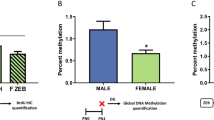The processes of histone acetylation in the brain underlie both the mechanisms supporting the long-term stable effects of early experience, transmitted to offspring generations by epigenetic inheritance, and learning. However, the role of acetylation in learning has previously been studied only in adult animals: high levels of learning can be linked with high levels of histone H3 acetylation in the brain. The role of acetylation processes in the mechanisms of early learning has not been addressed. We report here our studies of the effects of blockade of histone deacetylation with sodium valproate, which increases the level of acetylation of histone H3, on the outcome of training to olfactory discrimination in 8-day-old mice of strain 129Sv, which have low levels of learning with simulation of maternal grooming. Four doses of sodium valproate, given from day 3 to day 6 of postnatal development, were found to have gender-dependent actions: there were selective improvements in learning in males but not females, though females showed this seen after repeated administration of physiological saline. The possible epigenetic mechanisms underlying these gender-related differences are discussed.
Similar content being viewed by others

References
E. A. Aleksandrova, I. Yu. Zaraiskaya, and K. V. Anokhin, “Comparative analysis of the formation of behavior in mice of two inbred strains,” in: Behavior and Behavioral Ecology of Mammals, KMK, Moscow (2005), pp. 349–351.
O. V. Burenkova, E. A. Aleksandrova, and I. Yu. Zaraiskaya, “Deprivation of 129Sv mouse offspring of their mothers in early ontogeny improves olfactory learning with simulation of maternal grooming,” Byull. Eksperim. Biol. Med., 153, No. 5, 724–726 (2012).
A. V. Lobanov, O. N. Khokhlova, L. A. Zakharova, et al., “A model for analysis of neurotoxic actions on embryonic development in terms of assessment of somatosensory maturation in mice,” Toksikol. Vestn., No. 2, 22–25 (2008).
T. W. Bredy, R. A. Humpartzoomian, D. P. Campaign, and M. J. Meaney, “Partial reversal of the effect of maternal care on cognitive function through environmental enrichment,” Neuroscience, 118, 571–576 (2003).
T. W. Bredy and M. Barad, “The histone deacetylase inhibitor valproic acid enhances acquisition, extinction, and reconsolidation of conditioned fear,” Learn. Mem., 15, No. 1, 39–45 (2008).
I. Brouette-Lahlou, E. Vernet-Maury, and M. Vigouroux, “Role of pups’ ultrasonic calls in a particular maternal behavior in Wistar rat: pups’ anogenital licking,” Behav. Brain Res., 50, No. 1–2, 147–154 (1992).
F. A. Champagne, J. P. Curley, E. B. Keverne, and P. P. Bateson, “Natural variations in postpartum maternal care in inbred and outbred mice,” Physiol. Behav., 91, No. 2–3, 325–334 (2007).
W. Fischle, Y. Wang, and C. D. Allis, “Histone and chromatin cross-talk,” Curr. Opin. Cell Biol., 15, No. 2, 172–183 (2003).
R. A. Hodgson, D. H. Guthrie, and G. B. Varty, “Duration of ultrasonic vocalization in the isolated rat pup as a behavioral measure: sensitivity to anxiolytic and antidepressant drugs,” Pharmacol. Biochem. Behav., 88, No. 3, 341–348 (2008).
C. U. Johannessen and S. I. Johannessen, “Valproate: past, present, and future,” CNS Drug Rev., 9, No. 2, 199–216 (2003).
J. M. Levenson, K. J. O’Riordan, K. D. Brown, et al., “Regulation of histone deacetylation during memory formation in the hippocampus,” J. Biol. Chem., 2790, No. 39, 40,545–40,559 (2004).
K. I. Matsuda, H. Mori, and M. Kawata, “Epigenetic mechanisms are involved in sexual differentiation of the brain,” Rev. Endocr. Metab. Disord., 13, No. 3, 163–171 (2012).
M. J. Meaney, “Maternal care, gene expression, and the transmission of individual differences in stress reactivity across generations,” Annu. Rev. Neurosci., 24, 1161–1192 (2001).
E. K. Murray, A. Hien, G. J. de Vries, and N. G. Forger, “Epigenetic control of sexual differentiation of the bed nucleus of the stria terminalis,” Endocrinology, 150, No. 9, 4241–4247 (2009).
B. D. Strahl and C. D. Allis, “The language of covalent histone modifications,” Nature, 403, No. 6765, 41–45 (2000).
R. M. Sullivan, J. L. McGaugh, and M. Lon, “Norepinephrine-induced plasticity and one-trial olfactory learning in neonatal rats,” Brain Res. Dev. Brain Res., 60, No. 2, 219–228 (1991).
H. W. Tsai, P. A. Grant, and E. F. Rissman, “Sex differences in histone modifications in the neonatal mouse brain,” Epigenetics, 4, No. 1, 47–53 (2009).
C. G. Vecsey, J. D. Hawk, K. M. Lattal, et al., “Histone deacetylase inhibitors enhance memory and synaptic plasticity via CREB: CBP-dependent transcriptional activation,” J. Neurosci., 27, 6128–6140 (2007).
C. D. Walker, K. Kudreikis, A. Sherrerd, and C. C. Johnston, “Repeated neonatal pain influences maternal behavior, but not stress responsiveness in rat offspring,” Brain Res. Dev. Brain Res., 140, No. 2, 253–261 (2003).
I. C. Weaver, N. Cervoni, F. A. Champagne, et al., “Epigenetic programming by maternal behavior,” Nat. Neurosci., 7, No. 8, 847–854 (2004).
I. C. Weaver, F. A. Champagne, S. E. Brown, et al., “Reversal of maternal programming of stress responses in adult offspring through methyl supplementation: altering epigenetic marking later in life,” J. Neurosci., 25, No. 47, 11,045–11,054 (2005).
S. H. Yeh, C. H. Lin, and P. W. Gean, “Acetylation of nuclear factor-kB in rat amygdala improves long-term but not short-term retention of fear memory,“ Mol. Pharmacol., 65, 1286–1292 (2004).
Author information
Authors and Affiliations
Corresponding author
Additional information
Translated from Rossiiskii Fiziologicheskii Zhurnal imeni I. M. Sechenova, Vol. 99, No. 2, pp. 212–220, February, 2013.
Rights and permissions
About this article
Cite this article
Burenkova, O.V., Aleksandrova, E.A. & Zaraiskaya, I.Y. Gender-Dependent Actions of the Histone Deacetylase Blocker Sodium Valproate on Olfactory Learning in 129Sv Mice during the Early Postnatal Period. Neurosci Behav Physi 44, 1008–1013 (2014). https://doi.org/10.1007/s11055-014-0017-0
Received:
Revised:
Published:
Issue Date:
DOI: https://doi.org/10.1007/s11055-014-0017-0



